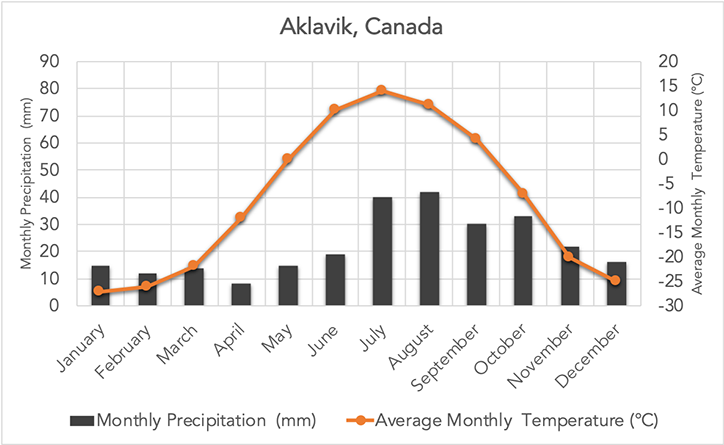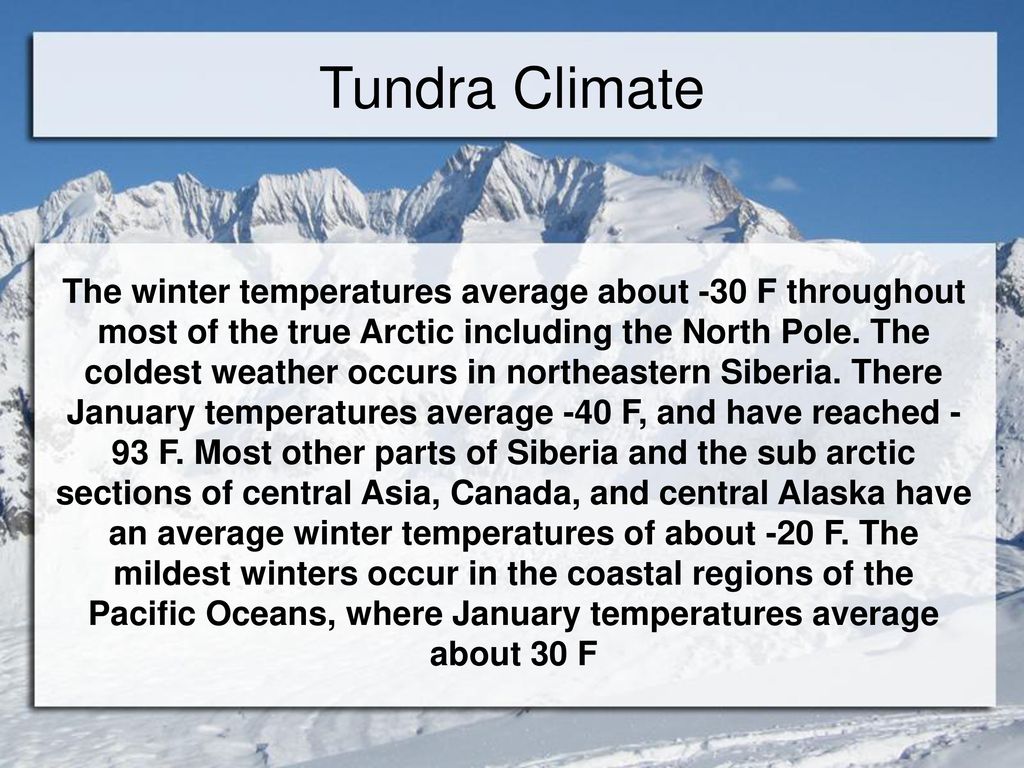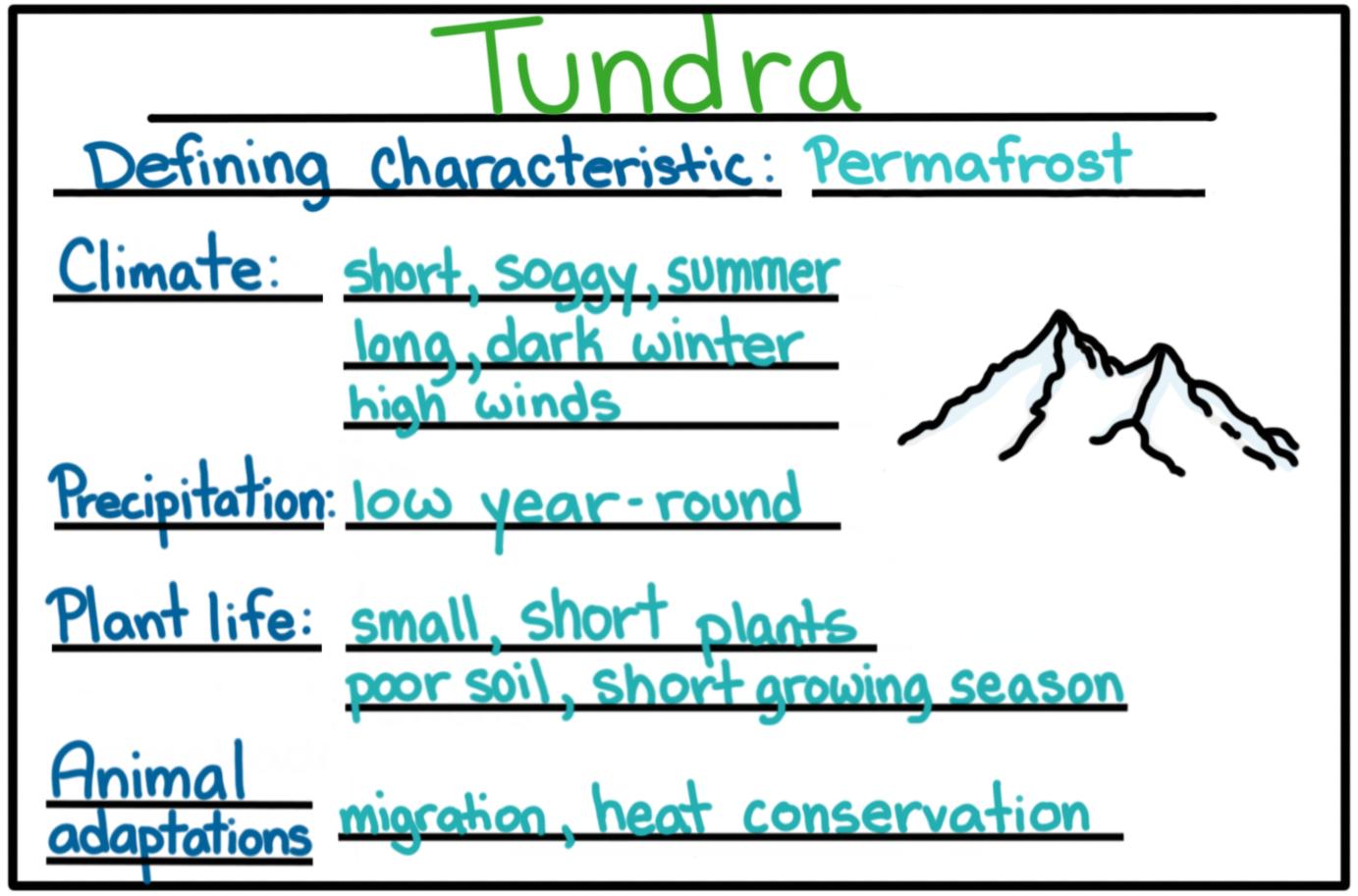Dead organic material functions as. Stunted forests occurring at the forest.
The tundra has short summers lasting from May to July when temperatures only rise to about 50 degrees Fahrenheit.

. Short summers long winters and permafrost. But even the sun cant warm the tundra much. Cold windy and dry.
Long summers short winters and little rain D. Despite the freezing conditions a lot of. Tundra lands are covered with snow for much of.
The land in tundra biome is normally frozen land and frozen grass. The tundra or the polar climate is characterized by general absence of insolation and sunlight and very low temperature throughout the year. Tundra Threats Explained.
Tundra areas include Northern parts of Canada Russia and Alaska. Alpine tundra transitions to subalpine forests below the tree line. The temperatures stay below 0C most of the year.
The rainfall may vary in different parts of the artic Yearly percipitation including melting snow is 15. Tundra is the coldest of all the biomes. They have long cold winters with high winds and average temperatures below freezing for six to ten months of the year.
Using a well labelled diagram explain how each of the following features were formed. Alpine tundra is distinguished from arctic tundra in that alpine tundra typically does not have permafrost and alpine soils are generally better drained than arctic soils. Composite Volcano 6 marks ii Volcanic plug.
Which choice best describes that tundra climate. Which characteristics describe a tundra climate. It has been called the land of the midnight sun.
The tundra is the coldest biome on Earth having average annual temperatures ranging from -40F in the winter to 65F in the summer. Description of the tundra climate Tundra environments are very cold with very little precipitation which falls mainly as snow. It is cold through all months of the year Summer is a brief period of milder climates when the sun shines almost 24 hours a day.
Temperatures remain below 0C most of the year. Climatic Conditions of Tundra in Arctic Regions. Explain four factors which led to the growth of the iron and steel in the Ruhr region of.
The average temperature is 34 degrees celcius but the average summer temperature is 3-12 degrees celcius which enables the biome to sustain life. The arctic tundra can be found in the northern hemisphere. The ground remains frozen apart from.
This severe climatic condition does not favour much vegetative growth and hence most of the tundra remains a barren land. This topic will explore characteristics such as climate plant animals that make this biome unique. Up to 24 cash back Weather Climate.
Tundra climate major climate type of the Köppen classification characterized by sub-freezing mean annual temperatures large annual temperature ranges but not as large as in the adjacent continental subarctic climate and moderately low precipitation. See answer 1 Best Answer. The Climate in the tundra is known for its cold desert like conditions.
In mid-winter January temperatures are as low as -35F. Locations with Tundra Climate Arctic Tundra. The polar climate is characterized by a very low mean annual temperature and its warmest month in June seldom rises to more than 50F.
E The tundra is a bleak and treeless place. Extreme heat with heavy rain for several months B. Explore the unique landscape of the tundra and meet.
Four equal seasons with few extremes C. Unlike the arctic tundra the alpine tundra can be found at the top of the worlds highest mountains. This biome is known to experience long winters and short summers.
The cold climate of the alpine tundra is caused by the low air temperatures and is similar to polar climate. Home to animals including Arctic foxes Vulpes lagopus polar bears. Tundra Biome occurs in latitudes of 55 degrees to 75 degrees north.
Differentiate between a spring and a well. Tundra regions typically get less than 25 centimeters 10 inches of precipitation annually which means these areas are also considered deserts. How has the recent negative travel advisories affected Kenyas economy.
Tundra comes from the Finnish word tunturi meaning treeless plain. The short summer lasts only 6 to 10 weeks. Tundras are among the worlds coldest harshest biomes with extreme temperatures and low rainfall.
The Tundra biome is the coldest climate biome on earth with an yearly average temperature less than 10 to 20 degrees Fahrenheit and precipitation mostly in the form of snow less than 100 millimetres per year. But these environments in the Arctic and on mountains are far from invulnerable displaying sensitivity to human disruptions and climate change. This hemisphere is also surrounding the North.
It is noted for its frost-molded landscapes extremely low temperatures little precipitation poor nutrients and short growing seasons. The tundra biome has a harsh frozen climate with low rainfall and high winds. And much colder in the interior.
Tundra ecosystems are treeless regions found in the Arctic and on the tops of mountains where the climate is cold and windy and rainfall is scant. Tundras are extremely cold have low biotic diversity and have simple vegetation. Muxakara and 8 more users found this answer helpful.

Tundra Biome By Debbie Oubay Ppt Download



0 Comments